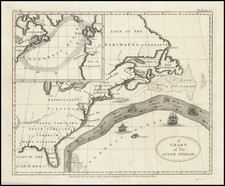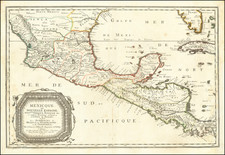Fine separately issued thick paper example of the US Coast Survey map of St. Augustine Harbor in Florida.
In addition to the thin paper examples of the map which were published to be bound into the annual official reports, the US Coast Survey typically printed a limited number of copies of each survey map on heavy paper, suitable for presentation or use at sea. These thick paper examples were also typically engraved, rather than using the cheaper printed methods employed for the official accounts, making for a finer appearance.
The present map of St. Augustine extends north along the Tolomato or North River and south along the Matanzas River, with St. Augustine in th center, Anastasia Island at the bottom and North Beach at the top.
Includes extensive topographical and hydrographical details, sailing directions, noets, tidal information and soundings, with notes on the local lighthouse. A fine example of this rare separately issued chart.
The United States Office of the Coast Survey began in 1807, when Thomas Jefferson founded the Survey of the Coast. However, the fledgling office was plagued by the War of 1812 and disagreements over whether it should be civilian or military controlled. The entity was re-founded in 1832 with Ferdinand Rudolph Hassler as its superintendent. Although a civilian agency, many military officers served the office; army officers tended to perform the topographic surveys, while naval officers conducted the hydrographic work.
The Survey’s history was greatly affected by larger events in American history. During the Civil War, while the agency was led by Alexander Dallas Bache (Benjamin Franklin’s grandson), the Survey provided the Union army with charts. Survey personnel accompanied blockading squadrons in the field, making new charts in the process.
After the Civil War, as the country was settled, the Coast Survey sent parties to make new maps, employing scientists and naturalists like John Muir and Louis Agassiz in the process. By 1926, the Survey expanded their purview further to include aeronautical charts. During the Great Depression, the Coast Survey employed over 10,000 people and in the Second World War the office oversaw the production of 100 million maps for the Allies. Since 1970, the Coastal and Geodetic Survey has formed part of the National Oceanic and Atmospheric Administration (NOAA) and it is still producing navigational products and services today.










![Florida [Railroad Map]](https://storage.googleapis.com/raremaps/img/small/90441.jpg)

![[ Gulf Coast & West Coast of Florida ] De Cust van Westindien Van La Desconoscida, tot C. Escondido. . .](https://storage.googleapis.com/raremaps/img/small/65741.jpg)
![[Untitled Coast chart of North Carolina, South Carolina, Georgia, and Florida, with insets of the harbor of Charleston, S.C. and the entrance of the Saint Johns River]](https://storage.googleapis.com/raremaps/img/small/91737.jpg)
![[ Native American about to Murder A Frenchman in a Dugout Canoe ] Petri Gambie Galli Caedes](https://storage.googleapis.com/raremaps/img/small/97871.jpg)